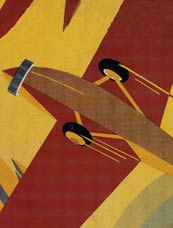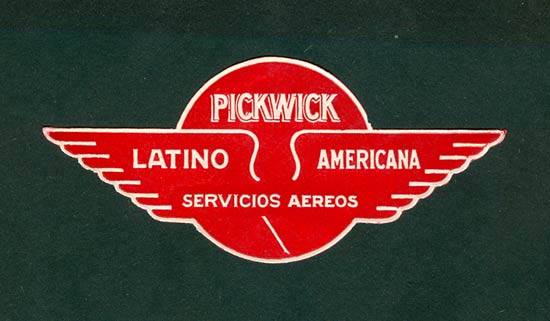E.C. McLeod, 1930, Age 28
,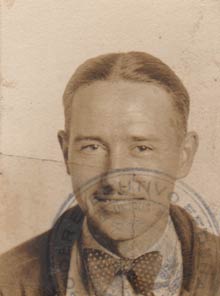 |
Rarely among Register pilots do we come to find even a single flight log book. Sometimes we're lucky to find a couple of pages, or even a whole one. Some examples of this good fortune on dmairfield.org are Bill Piper, Jr., Pancho Barnes, Zantford Granville and John Livingston and a few others.
Flight log books are records of pilots' flying activites. They generally include dates, aircraft registration numbers, hours and minutes flown and, sometimes, descriptive notes about the purpose of the flight. For pilot McLeod, we have six such books. And for the most part they're complete books.
The six flight log books of Elmer C. McLeod exhibited in this section cover the twenty-year period May 9, 1928 through March 31, 1948. They are described generally below by dates. As well, PDF files which you may download contain the entire contents of the individual books. You may download them ad lib for your own original study. The PDFs contain no internal commentary by your Webmaster. They stand on their own to yield a picture of the active, international flying life of pilot McLeod.
There are also two aircraft log books and a single engine log book discussed and presented similarly as PDF downloads. For aircraft record keeping, there is generally a separate book for the airframe, the engine and the propeller. The airframe log book records everything associated with the airplane except the engine and propeller, including records of routine maintenance, approved modifications, avionics, weight and balance changes and compliance with mandatory airworthiness issues. Likewise, the engine and propeller books contain the same information for those items.
Through the years, McLeod didn't fly much for pleasure. Rather, most of his flights were while under the employ of others. It is clear from his logs that he made his living by flying. McLeod's employers included Hobi Airways, Pickwick Airways, Aviation Service Company and Lockheed Aircraft. His logs also record his flights made with many different airplanes throughout the United States, Mexico, South America, Europe and Asia and the Far East, mostly while with Lockheed. If you are a fan of vintage Lockheed twin-engine transports and military variants (e.g. Electras and Hudsons), his later logs will be of great interest to you
McLeod was very fastidious in keeping his early logs, with each flight recorded, including the purpose, as well as running tallies of total flight hours, number of flights and miles flown. Here are his logs. The highlighted titles lead to the PDF downloads. PLEASE NOTE: For clarity, the page numbers I refer to below are the PDF page numbers, not the actual order of the pages in his pilot logs.
PILOT FLIGHT LOG BOOK #1 May 9, 1928 through August 7, 1929
This first book is important to us, because it records the itinerary that brought McLeod to his landing at Tucson, Thursday, April 11, 1929. At his biography page, linked above, you can see those pages as well as a chart of his flights that brought him from his point of origin (Wichita, KS), through Tucson, and on to his destination, Seattle, WA. Download the log as a PDF (file is 5.4Mb) by clicking the title, above. Below, the cover of the McLeod Collection's first log book.
Pilot Flight Log Book Cover, May 9, 1928 through August 7, 1929
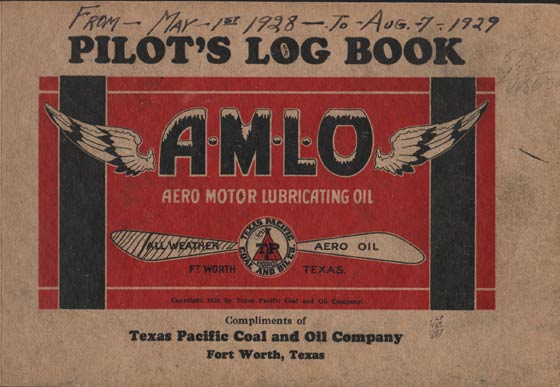 |
As you review the PDF, there are a few things to note in this log. First, it begins with a total flight time brought forward of 3,025 hours and 20 minutes distributed across 6,050 individual flights. Thus, this log by no means records his flight training or early flying experiences. That record probably occupies a couple of earlier books not in my possession. Does anyone KNOW where they are?
McLeod Log, Hobi Airways Co. Notation
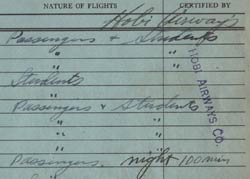 |
At the beginning of this book, you can see on PDF page 2 that there was a page torn out of his book (notice the perforations near the staples). I have no knowledge of where that page went or if it recorded any flight times or notes. It probably did not, because he noted his time and flights brought forward as of the first date recorded in the log, q.v., and in a summary he calculated on the last page of the log.
He flew two aircraft on this first page: a Hisso-powered Stearman, 3440, and 3977, an OX5-powered Travel Air. Neither of these craft appear in our Register. Other than the Travel Air NC8849, in which he visited Tucson, none of the dozen or more aircraft McLeod cited in this book are signed into the Davis-Monthan Register.
He changed his address twice during the tenure of this log. He moved from Los Angeles, CA to Aberdeen, WA sometime between May 9th and July 8, 1928. His itineraries changed abruptly from California to Washington State on June 13th, so this date is probably when his move was made. He flew mostly passengers, test and student training flights in the local area, associated mostly with his position at Hobi Airways of Eugene, OR, as indicated in the vignette from this log, above, left. He changed his address again, sometime between October 28th and November 19th, moving to a hotel in Eugene, OR.
The last page of this book records flights he made as ""asst. pilot on Tri motor Bach" for Pickwick Airways on the Glendale to San Diego route. He flew two different Bach trimotors (neither appear in the Register). His final flight recorded in this book on August 7, 1929 resulted in a crackup, "after takeoff from Glendale." He explicitly states that he was assistant pilot, and that John Wood was the "1st pilot." No reason was given for the accident, but McLeod did note the visibility as "hazy." McLeod's John Wood is probably not the same John Wood who signed our Register.
Also, on the final two pages of this book, we find McLeod changing employers from Hobi Airways to Pickwick Airways. If you look closely at the bottom of the next-to-last page, he summarizes his flights and hours for Hobi (489 hours, 5 minutes across 1,301 flights covering 42,210 miles). His grand total for all flight time was 3,514 hours and 25 minutes.
---o0o---
PILOT FLIGHT LOG BOOK #2 August 12, 1929 through March 1, 1931
The second book begins just five days after the previous one ends (PDF is 6.9Mb). There is no indication of what McLeod did between August 7 and 12. He may have been injured in the crackup on the 7th, or he may have taken the time to relocate from Oregon to California: the first page of this log records his address now as Glendale, CA.
McLeod now worked for Pickwick Airways (baggage label, right), which was owned by Thomas Morgan. Pickwick operated in California and Mexico. It was in business for only about a year, but it was one of the pioneering airlines of the American southwest. Other Register pilots worked for Pickwick, including Bill Gilpin. Thomas Morgan was married to Register pilot Mildred Morgan.
McLeod's first flight recorded in this log was in Register airplane NC8069, a trimotor Bach. He carried passengers from Glendale to San Diego and return.
When Pickwick closed its doors, which is demarcated crisply in this book as April 23, 1930, McLeod went to work for the Aviation Service Company. A Google search for "Aviation Service Company" +Glendale +1930 yields no relevant information. Does anyone KNOW anything about this company? Sometime near December 2, 1930 McLeod moved from Glendale down to Nogales, AZ and gave his address there as the Bowman Hotel at 314--316 Grand Ave. on the U.S. side of the border. The hotel, now a specialty store, was posted to the National Register of Historic Places on August 29, 1985.
His logged flights out of Nogales are all Aviation Service Company round trips into old Mexico, e.g. Los Mochis, Obregon, Mazatlan and Hermosillo. Near February 18, 1931, he moved back to Los Angeles, taking apartments there and in Glendale.
According to his log, on December 1, 1930, McLeod left Aviation Services and went to work for R.E. Havenstrite. R.E. Havenstrite was a partner in the Havenstrite Oil Company based in Los Angeles. As far as can be determined from his log, he remained with Havenstrite, living in Glendale, until the end of this second log book.
Through the years bound by this book, McLeod flew several Register airplanes. We already saw NC8069. There was also Fairchild NC9114, Ryans 307K, 313K and 308K, Travel Air NC8192 (owned by Tom Morgan, raced by Mildred, still Registered with the FAA and flying in New Zealand), and Buhl NC3763.
He closed this log on March 1, 1931 with a total of 4,397 hours and 55 minutes of flight time, 8,314 flights and 380,509 miles flown. As I said, he was meticulous in his record keeping.
---o0o---
PILOT FLIGHT LOG BOOK #3 March 2, 1931-August 24, 1935
The cover of this book is inscribed "March 2, 1931-August 24, 1936" (PDF is 8.8Mb). But McLeod made a 'typo" because the last entry is August 24, 1935. By far, most of the flights logged in McLeod's third book were in Ryan B-5 NC132W and Travel Air 6000 NC377M (not a Register airplane). Although it is difficult to decipher who he was working for, a few clues point to R.E. Havenstrite and to C.W. Gilpin.
Of special interest, between September 30 and October 26, 1932, McLeod made a trans-continental round trip, the first recorded by him in his logs (PDF pp. 10-11). His itinerary is charted below. The northernmost line is the eastbound route.
E.C. McLeod's Transcontinental Itinerary, September 30-October 26, 1932
(Source: Webmaster)
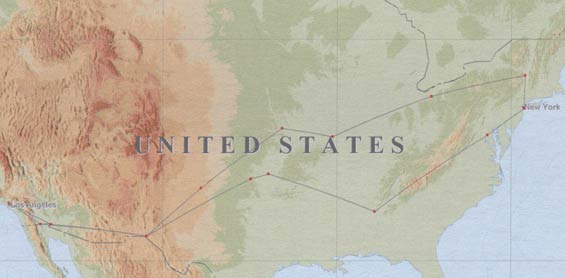 |
You will note from his log that there were numerous unidentified stops made between some of the points. I suspect between El Paso, TX and Calexico, CA on his return he probably stopped at Tucson again, since he indicated that he flew that leg with a stop in between.There is no information logged with this itinerary that suggests the purpose of the trip, or if there were any passengers aboard, but the initials "R.E.H." in the right hand column of his log suggest it was on behalf of Havenstrite. If he did stop at Tucson, he did not sign the Register. This is not noteworthy, as he did it several more times in the logs described below.
The itinerary he recorded in this log reads: Glendale, Yuma, El Paso, Amarillo, Kansas City, MO, St. Louis, Cleveland, OH, Albany, NY, New York City, Washington, DC, Birmingham, AL (in three legs), Tulsa, OK (in three legs), Guthrie, OK, El Paso, Calexico, CA (in two legs) and return to Glendale. His round trip covered approximately 4,900 nautical miles.
On the next to last page, he summarizes at the bottom, for March through August, 55 hours of flight in Lockheed Electras which are not logged anywhere earlier in his book. Likewise, over the same period he logs 20 hours of blind flying in a Kinner-powered Travel Air. Neither airplane is identified by registration number. This is a curious departure from the line-by-line, flight-by-flight accuracy generally shown in McLeod's record keeping.
Perhaps the six-months of Lockheed time was not logged because he didn't want his current employer (Havenstrite?) to know he might be considering a job with Lockheed. The benefit of the doubt goes to him, however, because his next log book clearly documents a change in his career to test pilot for Lockheed.
McLeod lived at four different addresses during the tenure of this book. Register aircraft flown include the Bach NC8069, and Ryan NC132W. His log ends with a total accumulated flight time of 5,325 hours, 30 minutes across 9,123 individual flights flights totaling 491,042 miles.
---o0o---
PILOT FLIGHT LOG BOOK #4 August 27, 1935-December 2, 1938
McLeod's fourth book (PDF is 9.6Mb) covers the dates August 27, 1935 through December 2, 1938. He worked for the Lockheed Aircraft Company for the whole time. Notice, for whatever reason, McLeod only used one side of the page to record his flights. His usual neatness and attention to detail began to flag near the end of this log. We can imagine why. He delivered Lockheed aircraft internationally, to India, Europe and South America, all in a very short time period. WIth a work schedule like that, something had to give, and it was his record keeping.
An historic finding in this log is that McLeod served as the manufacturing test pilot for the Lockheed 10A, NX/NR10620. This airplane is significant since it was flown by Amelia Earhart. McLeod flew 10620 in NX livery July 20-25, 1936. He noted on July 20th, "First Test. A&E." The "A&E" probably means he flew with an Airframe & Engine mechanic to help monitor engines and systems during the flight. He flew the airplane a total of 8:45 during those dates.
On August 5-9 he tested the airplane again for a total of 4:30. It wore NR livery in August, as it did when Earhart flew it to her disappearance less than a year later, on July 2, 1937. You can see Earhart flying and posing by NR10620 in the motion picture film at the link, and learn about the circumstances of her appearance in that film.
España, 25 Centavos, 1937 (Source: Webmaster)
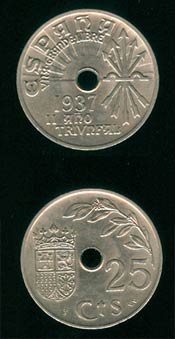 |
Throughout this book, McLeod's most frequent mount was the Lockheed Electra 10A, NC14946. It was serial number 1033 and it was the first aircraft logged in this book. This airplane was in the 1937 movie "The Man Who Found Himself." The link takes you to a YouTube video clip of the airplane in that film. It was used as an air ambulance in the film. Thanks to Tim Kalina for calling our attention to the clip. He says about the clip, "In the background, near the very end of the clip, you'll catch a glimpse of the GCAT terminal building [Grand Central Air Terminal]." You can read the registration number on the rudder, too.
His last flight with NC14946 was logged in early December, 1937. About this time it was sold by Lockheed and transferred to Spain. Coin, left, from your Webmaster's collection of items related to Davis-Monthan Register activities.
NC14946 took part in the Spanish Civil War (1936-1939) on the side of the Nationalists. According to one Web source, NC14946 was initially purchased for use by the Republicans, but it was hijacked while it was on ship board to Spain by Nationalists who used it for executive transport throughout the rest of the War. I do not know its fate after that. Does anyone KNOW?
As well as brief flights into Canada and Mexico from Los Angeles, this book logs three major international trips by McLeod flying Lockheed aircraft in India, Europe and South America. The trip to South America is documented in the Travel Documents section of the Collection.
During December-January 1937-38, McLeod was a guest of the 37th Maharaja of Jodhpur, Umaid Singh, who reigned from 1918-1947. A photograph of His Highness and a brief history of his reign is at the link. Note at the link that His Highness the Maharaja called flying, "the latest of our recreations," and that, "He loved flying so the Jodhpur Aerodrome became an international airport before Delhi with three trans-continental airlines stopping here."
H.H. Umaid Singh, Ca. 1940s (Source: Air Force Heritage Museum)
 |
A DIGRESSION
In November, 2011 your Webmaster visited Jodhpur, Rajasthan and had the pleasure and opportunity to photograph items at the small Air Force Heritage Museum maintained by the Indian Air Force. Photograph, right, of Lieutenant General Air Vice Marshall His Highness Maharaja Umaid Singh of the Indian Air Force. Besides being a sportsman and outdoorsman, his passion was flying. Driven by his pioneering zeal Jodhpur became one of the most important centers of aviation in India during his time.
In 1931 the Jodhpur Flying Club was organized around two deHavilland Moth aircraft. The Club progressed rapidly and by 1938 was at the forefront of civil aviation in India. The Jodhpur airfield grew similarly, and was serviced by three international airlines by 1938. The first landing area in Jodhpur was laid down in 1924. By 1938 there were 23 airfields throughout the state of Rajasthan. It was not unusual for the Maharaja to fly into one of them unannounced to inspect and supervise various public works.
The Maharaja was the first Indian Prince to obtain a Level 'A' Flying license. He progressed to multiengine aircraft, and it was then the Maharaja and McLeod met. Although it is not clear from his log book if McLeod ferried the Lockheed 12A twin-engined airplane to the Maharaja for his personal use, it is clear from this REFERENCE (pages 73-78) that he did not. The Maharaja's airplane arrived at Karachi in October aboard the ship M.S. Tosari. There it was assembled by the Chief Engineer of the Jodhpur Flying Club and and flown to Jodhpur by McLeod. It wasn't until December 12th that McLeod began to log his time with the Maharaja in order to transition the Maharaja's new airplane via training and demostration flights to its new VIP owner and his personal pilot, identified as Geoffrey Godwin. The Maharaja's Lockheed was identified as VT-AJN. VT-AJN was serial number 1237.
Shortly, VT-AJN was impressed by the British military becoming V4732 on November 15, 1939, shortly after McLeod flew it last. Its registration was cancelled January 29, 1940. While the Maharaja owned it, however, he lost no opportunity to fly guests and friends around in it.
According to the REFERENCE linked above, McLeod did, however, fly a 12A from Europe, across the Mediterranean and eastward to India. This airplane was destined for the Maharaja of Jammu and Kashmir (who was not to be outdone by the Maharaja of Jodhpur). That airplane wore Indian registration VT-AJS, S/N 1238, and was named "Sapphire." McLeod left that airplane in Kashmir and, as described above, flew VT-AJN to Jodhpur on December 1st according to his log (but December 18th according to the REFERENCE).
As well as various items in the museum, I was able to photograph the current Jodhpur airport from the front of the current palace. Below, a view of the present airport, which is currently served by two internal airlines, Air India and Jet Airways. The airport's single runway is visible as the light streak near the horizon.
Jodhpur Airport, November, 2011 (Source: Webmaster)
 |
The Maharaja's base of operations was his palace, which was still under construction at the time of McLeod's visit (constructed between 1928 and 1943). Below, from the Museum, an aerial photograph of the palace.
Aerial View of the Jodhpur Palace, November, 2011 (Source: Air Force Heritage Museum)
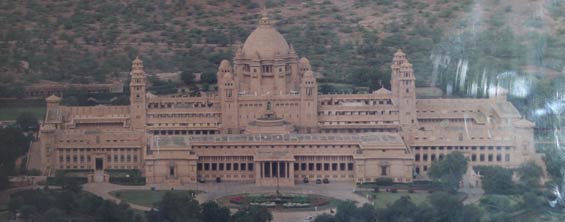 |
Below, a frontal view of the palace taken in November, 2011.
Frontal View of the Jodhpur Palace, November, 2011 (Source: Webmaster)
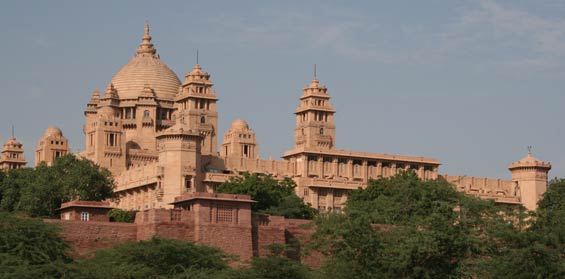 |
The wall from which the airfield photograph was taken is the darker one near the bottom of this photograph.
The following images are shared with us by Dr. Mahendra Singh Tanwar of the Museum. They are news articles from various sources that cite the Maharaja and his contributions and interest in aviation in India on the eve of WWII, and during the war.
Below, a full-page spread from The Illustrated Weekly of India for December 15, 1935. Notice the photograph of the Maharaja in the round vignette.
The Illustrated Weekly of India, December 15, 1935 (Source: Air Force Heritage Museum via M. Singh Tanwar)
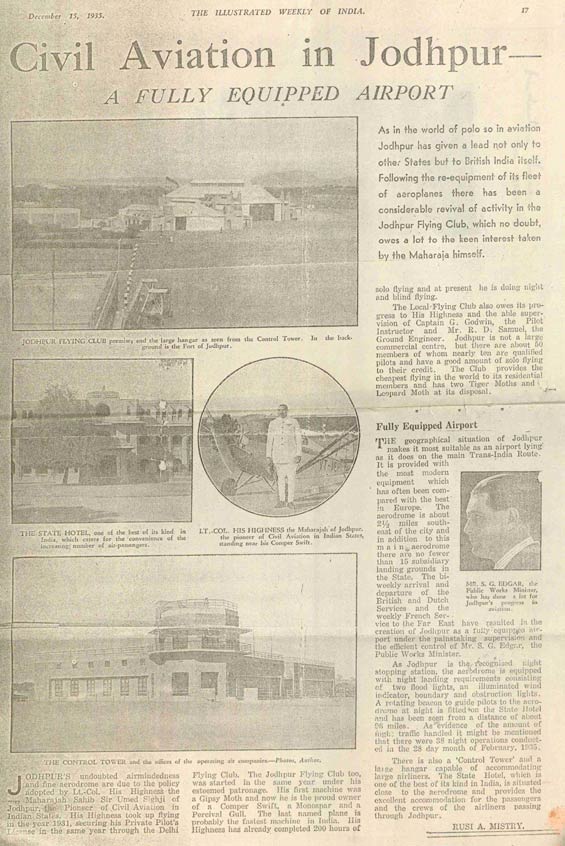 |
Below, is an article in Hindi annotated from the Illustrated Darbar, a publication of December 21, 1937. I was unable to find any online reference to the Illustrated Darbar in either Hindi or English.
Illustrated Darbar, December 21, 1937 (Source: Air Force Heritage Museum via M. Singh Tanwar)
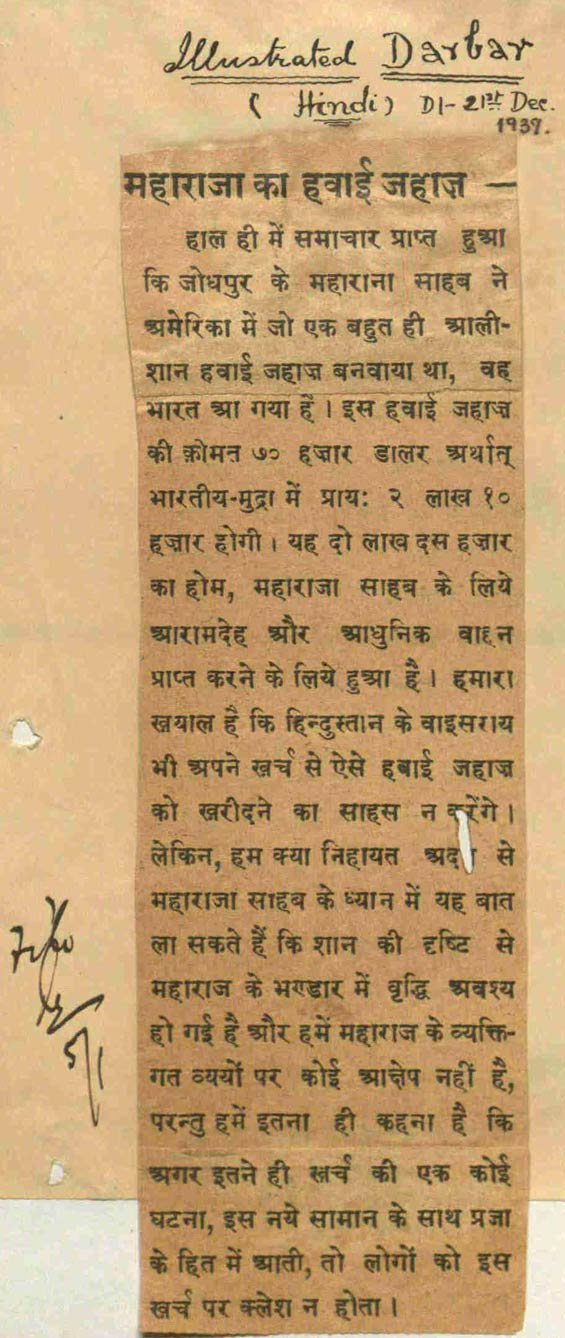 |
Dr. Tanwar of the Museum provides the following translation of the Hindi article. From the last sentence, we can interpret the author of the original as being a humanitarian.
Illustrated Darbar (Hindi), Date 21st December 1937
Airplane of Maharaja
Recently we got news that Jodhpur's Maharaja Sahib who ordered a fabulous aircraft from America, came to India. This aircraft will cot Seventy Thousand Dollar's mean's Rupee's Two Lakh & Ten Thousand in Indian rupee is spent for acquiring comfortable and modern vehicle for Maharaja Sahib. Our opinion is that even viceroy of India will not dare to purchase such aircraft from his expenses. But with due respect we wish to bring in kind notice of Maharaja Sahib that no doubt it will increase his wealth and we do not have any objection on his personal expenditure. But we just want to say that if such huge expenditure may have been spent for public welfare then public has no tension.
|
Below, from the Times of India dated April 7, 1943, an article documenting a gift of £75,000 to the War effort.
Times of India, April 7, 1943 (Source: Air Force Heritage Museum via M. Singh Tanwar)
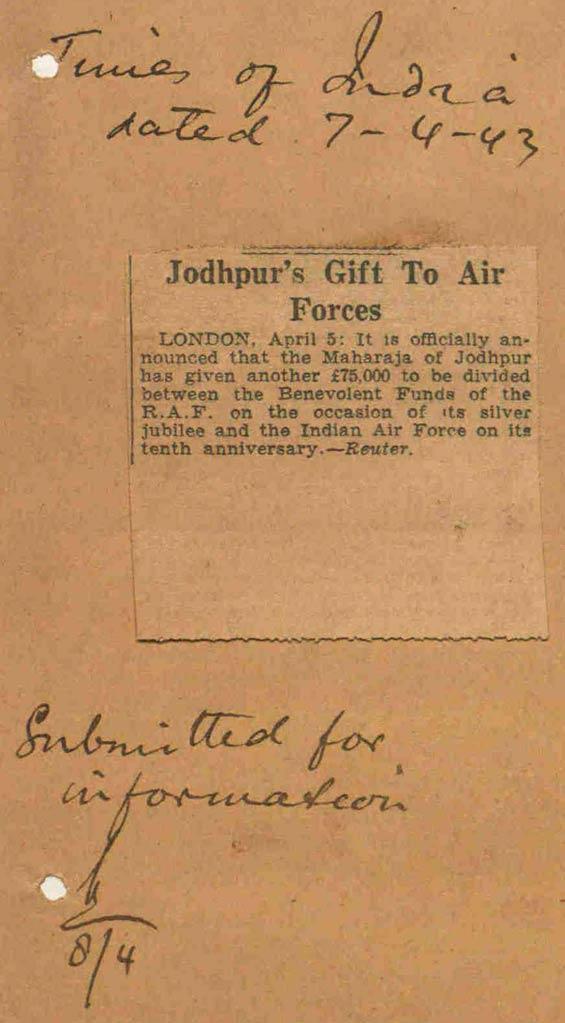 |
Finally, from the Illustrated Weekly of India for April 11, 1943, this article cites the Marharaja's participation at a cadet parade.
Illustrated Weekly of India, April 11, 1943 (Source: Air Force Heritage Museum via M. Singh Tanwar)
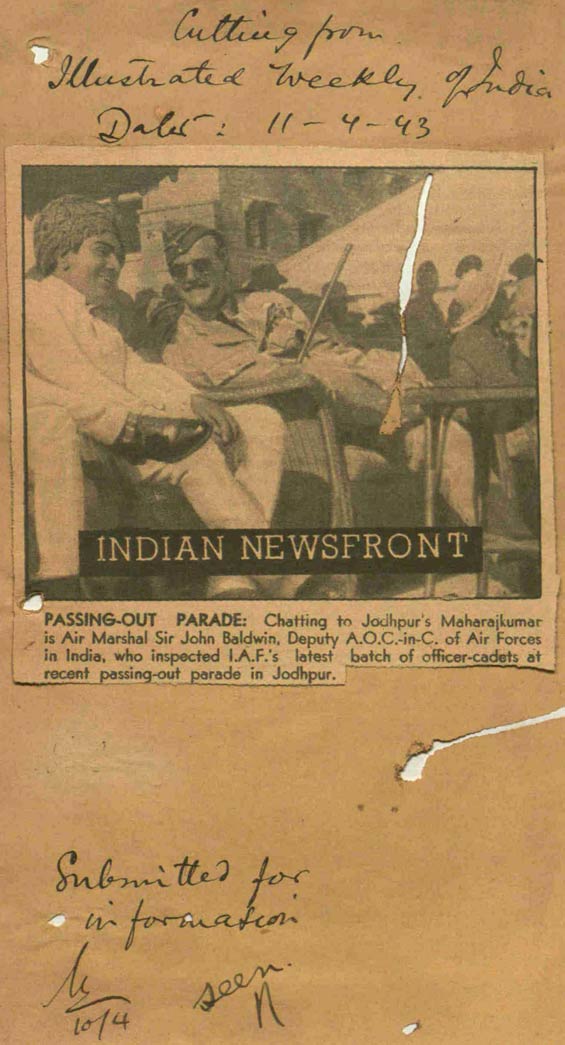 |
Below, from December 9, 1944, three pages of photographs of Royal duties during WWII from the War Supplement of the Jodhpur Government Gazette.
Jodphur Government Gazette, December 9, 1944 (Source: Air Force Heritage Museum via M. Singh Tanwar)
 |
Jodphur Government Gazette, December 9, 1944 (Source: Air Force Heritage Museum via M. Singh Tanwar)
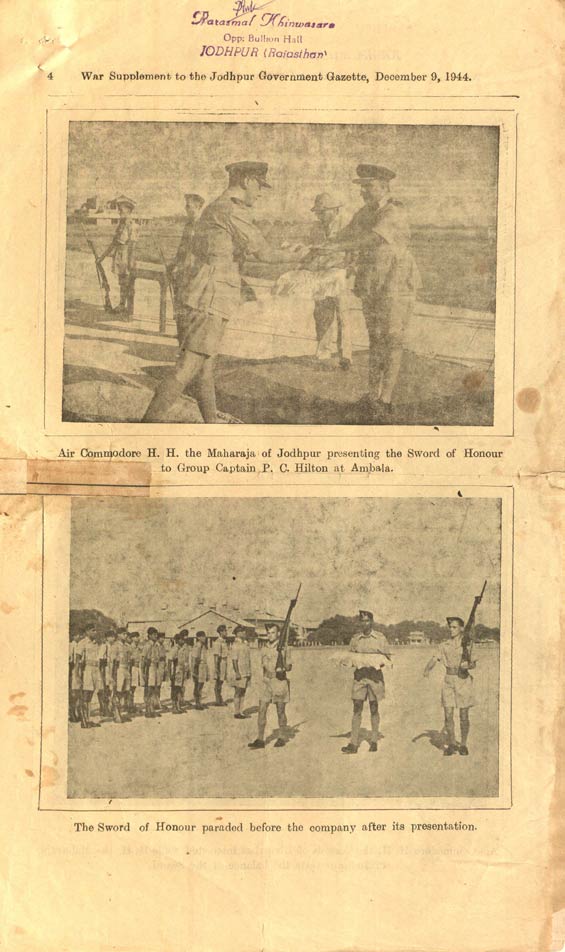 |
Jodphur Government Gazette, December 9, 1944 (Source: Air Force Heritage Museum via M. Singh Tanwar)
 |
END DIGRESSION
Your Webmaster and Guide Discussing McLeod Log Entries, November 8, 2011 (Source Webmaster)
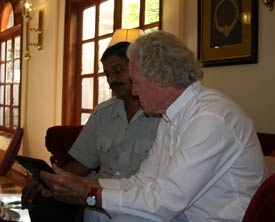 |
Interestingly, the international travel recorded near the end of this flight log book resulted in an unconventional addendum to McLeod's book in the form of typewritten pages summarizing his flights in India. This three-page, legal-sized document was folded neatly inside log book #4. At right, I discuss this addendum with the museum guide via images carried to India on my tablet.
Below, a copy of the hand-typed first page of the log addendum provided by the Maharaja's office. Across three pages it neatly summarizes the work that McLeod did in carrying His Highness and his passengers on cross-country flights, and in providing instruction to him and his First Officer G.H. Godwin (Godwin is mentioned in the first article posted above).
In total, he flew 29 hours in the Maharaja's airplane. The entire addendum is exhibited horizontally in the PDF downloadable as Log Book #4, above. I exhibit the sample page vertically here for readability.
Partial Record of McLeod's Flights with the Maharaja of Jodhpur, 1937-38
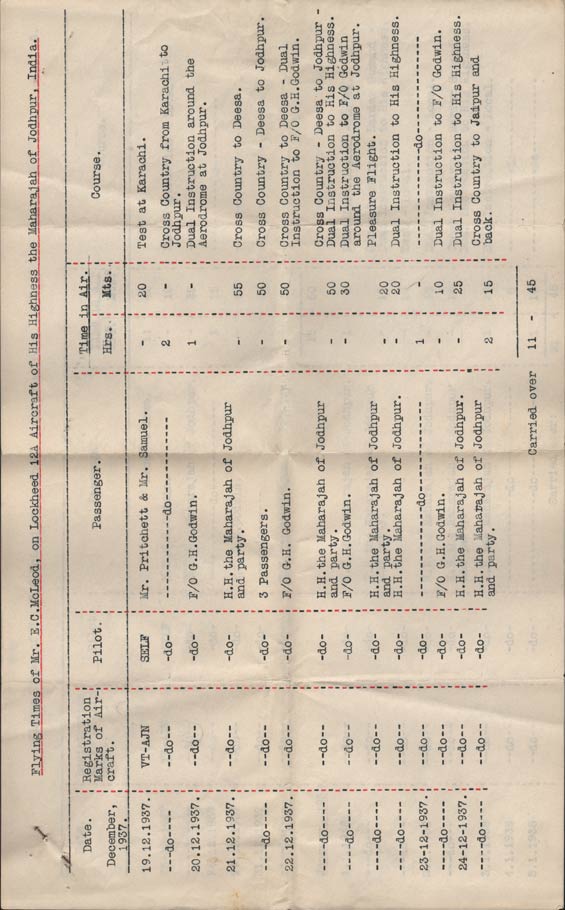 |
Notice the straight pin, above, used to attach the page corners, rather than a staple. Finally, one might ask the question, "isn't there a clothing article, namely breeches, called 'jodhpurs'?" The answer would be "yes," and the history of jodhpurs is here. It is coincidental that twill jodhpurs, worn with high-top boots, became the preferred breeches for Golden Age pilots, male and female alike.
In this log, some of McLeod's log pages are countersigned and validated by Lockheed VP and Register passenger Carl Squier. This 4th log ends with McLeod delivering an Electra 10A, YV-AVO, to Venezuela. The airplane, serial number 1110, was purchased in September, 1937 and it served with Linea Aereas Venezolanas. He ended this book with a grand total of 7,047 hours and 55 minutes of flight time, comprising at least 10,582 trips across at least 703,400 miles.
---o0o---
PILOT FLIGHT LOG BOOK #5 September 23, 1938-May 9, 1940
McLeod's fifth book (PDF is 4.0Mb) covers the dates September 23, 1938 through May 9, 1940. This book logs many long foreign trips for aircraft delivery and pilot training.
He continued his work for the Lockheed Aircraft Company the whole time. He continued also his habit of only using one side of the page to record his flights. About May, 1939 he temporarily starts using both sides of the page again, but it appears the handwriting is not his. Perhaps he turned over responsibility for maintaining his log to the administrative staff at Lockheed for a short period, because on September 1, he is writing his log again and using one side of the page.
On September 29-30, 1938, McLeod flew one of a few fixed, tricycle-gear 12As made. This one was the Navy's XJO-3 (NC18694). He flew it on two hops totaling 1 hour and 55 minutes. The XJO-3 was intended for carrier landing tests on the USS Lexington to assess the suitability of twin-engined tricycle-gear aircraft for carrier operations.
On October 2, 1938 he flew NC14949 (IPDF page 2), identified as a Stearman Hammond, for 50 minutes. Interestingly, this number was assigned to a Douglas DC-2 which crashed in Romania in 1937. It is not unusual for a cancelled registration number to be applied to another airplane, and this is probably an example of a reapplication. I can find no record of a Stearman Hammond with that number, however. Can anyone HELP?
Later in the year and into 1939 he test flew numerous Lockheed 10s and 12s destined for foreign owners, including YV-ADE (Venezuela), YV-ADI (Venezuela; crashed at Barcelona, Venezuela July 25, 1944), G-AFXP (Great Britain, owned by His Highness the Maharajah of Jaipur -- Jaipur is in north-central India --, which McLeod delivered there), YU-SDA (Yugoslavia), and at least one Dutch Lockheed 14.
During February-March, 1939 he flew from Burbank to Colombia, S.A. with NC110, a Lockheed 10E. It was a delivery flight for Saco Airlines and his flight time is documented on PDF pages 5-6. He flew for Saco for 22 hours as documented on a fold-out letter signed by the Technical Director of the company. Another delivery flight in May took him from Burbank to Chile flying NX18955 (PDF page 9). This airplane was an Electra 12A converted to a prototype bomber trainer identified as a model 212. He returned to California in June where it appears that he took a hiatus in July and returned to flight testing on August 5th.
Lockheed 14B (?) at Capetown, South Africa, Ca. 1940
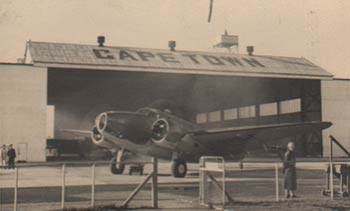 |
There are two pages torn out of this book between the entries for December 1st and 22nd 1939. There was probably some flight activity recorded on them, because three weeks is a long time for McLeod not to fly. They are missing, however, and we'll probably never know. There is also a gap between December 22, 1939 and February 8, 1940. His December flight was in California at the United Air Terminal. In February he was logging time in Southeast Asia and India again, so the January hiatus was probably travel time aboard ship west to the Orient.
On PDF page 14, we find McLeod in India on April 6th flying from Jaipur to Bombay and return in G-AFXP. On May 1st we find him in Capetown, South Africa with a model 14B bomber. Photo, right, from the Collection was clearly taken in Capetown.
He ends this log with a total flight time of 7,418 hours. He did not tally his trips and miles flown.
---o0o---
PILOT FLIGHT LOG BOOK #6 July 30, 1940-May 18, 1944
This book, although it records McLeod's flights, was not written in very much by him. Except for the ex libris, his signatures authorizing each page, and a few calculations, it is completely in someone else's handwriting. Curiously, it is only half filled, which is unusual because it spans almost four years. Unlike the soft cover Richfield books, this one is hard covered and supplied by Texaco.
At the start of this log (PDF is 8.9Mb), McLeod lived at 637 Grinnell Drive, Burbank, CA. According to Google Earth (q.v.), the address still exists in a neighborhood of many backyard swimming pools. It is a few blocks southeast of the John Muir Middle School and a mile or so north of the Golden State Freeway. I don't know if the building is the same 1940s-era structure.
On PDF page 3, two other Register pilots touched McLeod's log. As Lockheed Chief Pilot, Marshall Headle stamped and signed across the lower left-hand page. And Robert Dake, then an inspector for the Civil Aeronautics Authority, renewed McLeod's pilot certificate on January 15, 1941.
This log is filled with production testing of many new aircraft. He spent less time ferrying aircraft. In an unusual occurrence, one flight on PDF page 12 is even identified as a "pleasure" flight. On June 13, 1941 he flew the Stinson Reliant NC17191 (S/N 5706) from Burbank to San Francisco with a return on the 15th. Within a few days he was back to testing. Photographs of the Stinson are at this link and this link. Within a year, the Stinson would be impressed into military service.
Lockheed A-29-LO Hudson, Ca. 1941 (Source: Web)
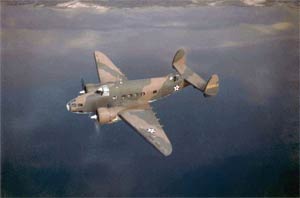 |
On PDF page 14, on November 15th, McLeod flew 41-23257 for its first production test. The series 41-23248 through 41-23260 were Lockheed A-29-LO Hudsons (image, right). According to Joe Baugher's site, all of them were allocated RAF serial numbers but were not delivered to Britain. Instead, all of them were diverted to China. The beginning of U.S. formal involvement in WWII was about three weeks away.
PDF page 15 takes McLeod to the eve of WWII. On December 5th and 6th, he ferried NC34908 from Burbank to Miami for what was described as a "Delivery Ferry." After the beginning of WWII on December 7th, McLeod's log is blank until January 23, 1942. It is unknown if he was unable to get back to California from Florida, or if the first six weeks after the outbreak of war were taken up with planning and ironing out the kinds of flight restrictions that would blanket U.S. coastal areas throughout the war. His flights through the rest of this log are spent on routine production testing, "Army acceptance," and radio and instrument checks. There is a sense, not unexpected, of the immediacy around getting aircraft built, tested, approved and flying on behalf of the military.
PDF page 20 has an adding machine tape summation attached to it by a paper clip. That tape is written on both sides and is presented as PDF page 21. This log ends on the next page with inscrutable summations. Note that he logged Link flight simulator time.
---o0o---
AIRPLANE LOG BOOK #7 Ryan B-5 NC132W, October 24, 1930 to July 29, 1932
Early in its life, NC132W was owned and flown by Pickwick Airways, of which Register pilot Tom Morgan was the owner. Morgan himself flew NC132W to Tucson once, on Tuesday, October 28, 1930. Based at Los Angeles, CA, he carried two unidentified (their names are unreadable in the Register) passengers. They were eastbound to El Paso, TX. The second page of the PDF (file is 17.3Mb, it's a big one) shows where Morgan inspected and signed off on the condition of the airplane on October 28th. Other pilots flying the airplane during 1930 were McLeod, H.C. Scovell and J.E. Waterhouse. Scovell and Waterhouse are not Register pilots. McLeod was the most frequent pilot during the last two months of 1930 and he was the exclusive pilot through 1931, save for one flight on July 30th made by pilot F.M. Oberg (not a Register pilot).
Cover, Airplane Log, Ryan NC132W, 1930-32
 |
This particular log is of great interest because it records the flight activities of at least two Register pilots, one of whom landed the airplane at Tucson. It also cites the serial number of its engine. Note that NC132W flew behind a Wright R-975 engine, S/N 10581. The log book for this engine is exhibited just below as part of the McLeod Collection.
On October 27, 1931, a newly overhauled engine, S/N 10720 was installed. S/N 10581 had accumulated 485 hours and 25 minutes of flight and ground time.
I'm looking for photographs and information about this airplane. If you can HELP, please let me know. NC132W is the airplane that McLeod flew across the United States in the fall of 1932 for which the itinerary is pictured above under Flight Log Book #3. Not surprisingly, the aircraft log mirrors the flight times and waypoints McLeod listed in his book #3.
---o0o---
ENGINE LOG BOOK #8 Wright R-975, S/N 10581, 300HP February 17, 1933 to July 22, 1935
Wright R-975 Engine Diagram (Source: Aircraft Yearbook)
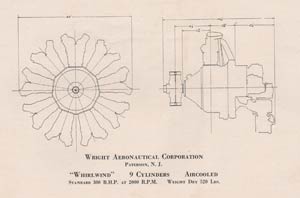 |
As mentioned above, this log book (PDF is 4.6Mb) documents the life of the Wright engine that powered NC132W. Curiously, the book serves as both an engine log AND a pilot log (see also log #9, below). McLeod entered his flights and destinations at the end of the book, as well as a record of maintenance on the engine. Note that this is a Wright engine documented in a Pratt & Whitney book!
At right, a diagram of the Wright R-975 (AKA J-6-9) from the Aircraft Yearbook of 1929, page 352. This was a very common radial engine used in Golden Age aircraft after its introduction in 1928. Further, during WWII, it was adapted to power armored vehicles and tanks.
NC132W flew for both Pickwick Airways and Gilpin Airlines. The data page from the log, below, cites R.E. Havenstrite as the owner of the engine. Havenstrite appears in at least three of McLeod's logs (numbers 1, 8 and 9). It is not clear how the engine was purchased or transferred to Havenstrite. Note that the propeller hub and blade identification numbers are included at the bottom of the page. There is usually a separate log for the propeller, but it is not among the McLeod Collection.
Data Page From Engine Log
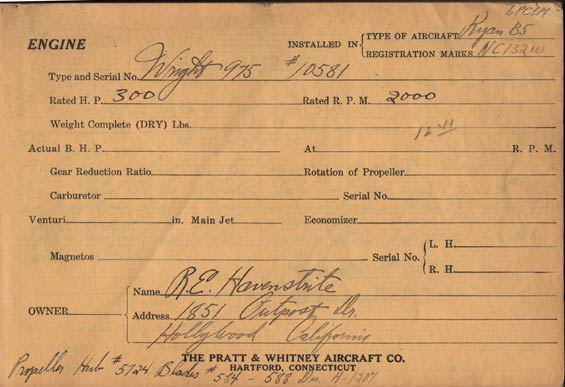 |
As mentioned in the airplane log, above, on October 27, 1931, a newly overhauled engine (S/N 10720) was installed in NC132W. It appears that S/N 10581 was itself overhauled and reinstalled in 132W on February 20, 1933. This date is where this engine log begins.
---o0o---
AIRPLANE LOG BOOK #9 Douglas DC-3C NC63250, April 3, 1946 to March 31, 1948
This airplane was built originally in 1945 (October 15th?) by Douglas Aircraft Corporation as a C-47B-50-DK Skytrain, USAAC number 45-1059 (S/N 17062). Since it was built just over a month after the end of WWII, it appears that it was immediately released by the military to civilian ownership.
At the beginning of this log book (PDF is 8.5Mb), PDF page 2 lists the owner as Havenstrite Aircraft, Inc. (refer to McLeod's Flight Log Book #2, above). It appears that Havenstrite took ownership of the airplane directly from the Army Air Corps sometime in April, 1946. Its total flight time to that date, if any, is not mentioned, nor is the exact date when it received its civilian registry. According to this log, however, the interior was converted from the C-47B military cargo configuration to a 15-passenger civilian transport somewhere between April and June, 1946.
In its new configuration, the airplane was used extensively for executive transportation until the log closes with its last entry on March 31, 1948 with the notation that the record was being, "Transferred to new log book." That notation was initialed by "JBB" who held (pilot?) license number 6314. During these two years between 1946 and 1948, the airplane traveled from California to the Carolinas and from Canada/Alaska to the Caribbean and Chile.
This record is frustrating to analyze, because what looks like McLeod's handwriting appears on only a very few pages (e.g. PDF page 12). In this way, it is similar to his Flight Log Book #6, which was probably maintained by Lockheed administrative staff. However, his signature appears nowhere in this book. None of the flights on any of the pages is certified by McLeod's signature that he was the pilot in command. To this day it is customary that a pilot's signature appears on every page of a flight log alledging that, yes, these flights and hours were legally flown by the signer.
Was he the pilot in command of any of the flights? From this log, only circumstantial evidence supports the possibility that he was. Namely, the book was in his possession (normally, an aircraft log book would follow the airplane from owner to owner). A few lines are in his handwriting. He had extensive experience flying in Central and South America. And, fifteen years earlier he had worked for Havenstrite.
NC63250, Ca. 1960-62 (Source: Web)
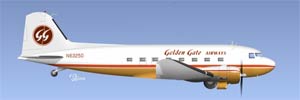 |
According to one Web source, later in its life NC63250, left, operated with Golden State Airways, an intrastate carrier operating between San Francisco, San Carlos and Lake Tahoe. The FAA revoked Golden State's license in November, 1962.
Like his Flight Log Book #4, this book has typewritten additions folded and tucked inside it. Of the four pages, three (PDF pages 8-10) summarize flight times and the fourth (PDF page 23) appears to be a mimeographed instruction sheet for changing the brushes of an electric shoe polisher. Perhaps routinely shined shoes is another example of McLeod's fastidiousness.
What remains is that an interesting aspect of this log is that it mixes flight itineraries with maintenance activities, all in the same book (usually a pilot's flight activites are kept in a log separate from the maintenance performed on an airframe, engine or propeller). In this way it is similar to his log for NC132W, above. As well, it's written with both fountain or nib pens and ink, and with the new-fangled, at the time, ball point pens. The ball point script is easy to pick out, as the lines are thick and characterized by pesky skips that were characteristic with the new devices, which began to make their way into common use circa 1945. Another Register entity, the Fokker Super Universal NC126M, has a direct relationship with pens (q.v.).
NC63250 met its end on July 20, 1979 enroute off the coast of Hawaii after a trans-Pacific flight from San Jose, CA with Trans National Airlines. The link provides details of the accident and states, "The pilot was forced to ditch the plane as he had become lost due to a failure of the Loran navigation equipment. The wreckage was never recovered."
---o0o---
Besides his six flight logs and the other three logs, we are fortunate to have other raw materials from across twenty years of pilot McLeod's life in aviation. As sometimes happens, the items in this Collection were at auction on eBay during February, 2011. Friend of dmairfield.org, Tim Kalina, bid, won and donated all the items to Delta Mike Airfield, Inc. We owe Tim great thanks for sharing these artifacts with us. To review these other items, please direct your browser to the index for the Elmer C. McLeod Photograph and Document Collection.
---o0o---
THIS PAGE UPLOADED: 05/07/11 REVISED: 04/01/12, 04/24/12
|

